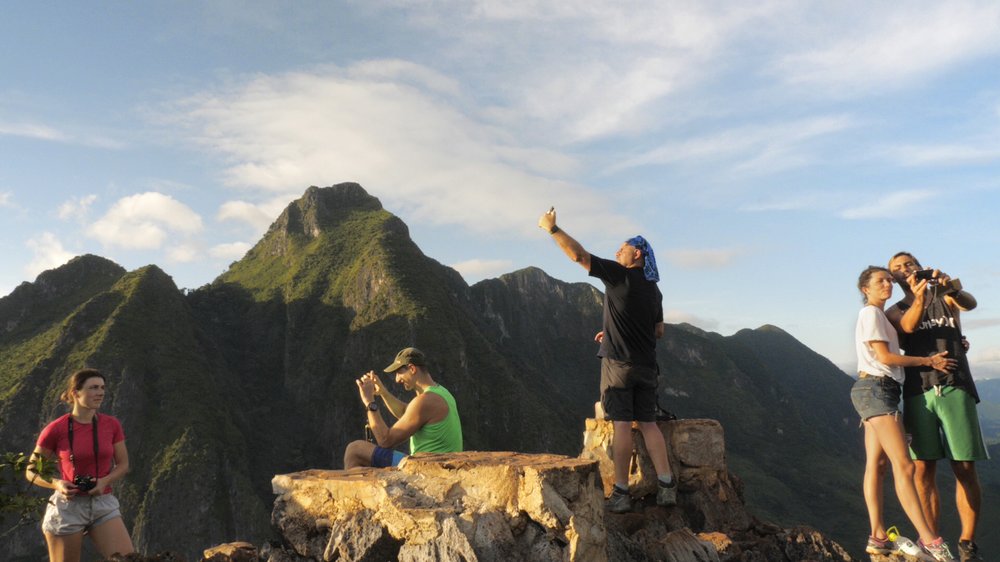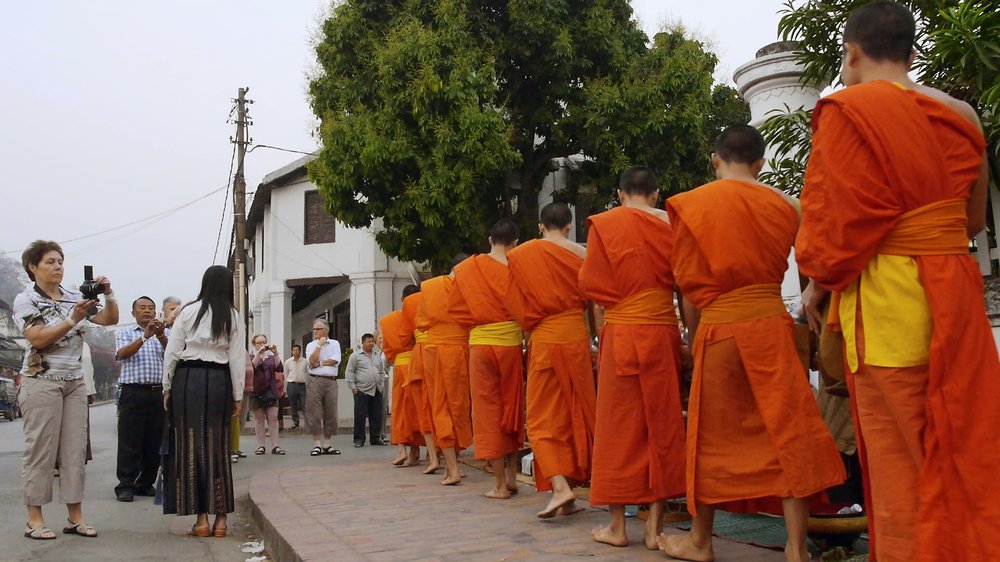Selfies and Saffron in Modern Laos
Kimi Takesue's latest documentary, "Onlookers," travels to Laos and delves into cross-cultural encounters. Tourists capture selfies in "Onlookers." Image courtesy of Kimikat Productions
Tourists capture selfies in "Onlookers." Image courtesy of Kimikat Productions
“Onlookers” can be streamed until March 23 on Metrograph at Home
Laos attracts approximately four million tourists annually, a traffic that comprises upwards of 10% of the Southeast Asian country’s economy and employs 300,000 people. Two generations before its rise as a vacation destination, however, it had a very different reputation in the region. After gaining independence from France in 1953, the U.S. Air Force dropped more than two million tons of ordinance on the small agrarian Buddhist nation, bestowing upon it the mantle of most bombed country in history.
While acknowledging this traumatic past, the experimental filmmaker Kimi Takesue is focused on the present in her third nonfiction feature, “Onlookers.” Her subject is the social dynamic between tourists—mostly French and American—and an ancient culture. It is a careful study of modern travel, voyeurism and cross-cultural encounter, told through observations and musings of tangerine-colored robed monks, almsgivers, and white visitors engaged in activities that are often out of synch with traditional Laotian society.
In its best moments, “Onlookers” peels back the layers of commodified culture to reveal the deep and enduring pleasures of travel.
Takesue filmed “Onlookers” across two month-long visits in the months before the COVID-19. It is the continuation of her trilogy focused on the cultures of the Andes (“Heaven’s Crossroad”), Vietnam (“Looking for Adventure”) and Uganda (“Where Are You Taking Me?”). In an interview with Filmmaker Magazine, Takesue explained that her decision to expand the series into into Laos was due to the country’s “beauty and slow pace of life” combined with its rapid growth, in particular its integration into Southeast Asia’s backpacker and tourism circuit.
The dialogue is sparse and she does not subtitle the tourists’ speech. She also shuns the voiceover device, letting the footage and passersby speak for themselves. As in her earlier work, she stabilizes her camera in master tableaux shots to emphasize the eye-popping colors of the historic buildings and grass. The scenes appear as motion postcards sedately unspooling life’s minutiae, a pacing that, depending on the scene, can be comical or suggest transcendence.

“Onlookers” is less interested in how tourists spend their time in Laos than the labor required for residents and travelers to participate in tourism. Her camera follows vendors as they set up their shops, and new arrivals as carry their backpacks and duffle bags down busy streets. Often these scenes contrast the two groups’ conflicting perspectives on Laotian culture and common objects. A white woman bangs a gong with no rhythm early in the doc, missing every beat, winning praise from her tour guide. In the next shot, monks perform a ritual involving the same instrument, hitting all of the composition’s notes in sync. This attracts more tourists to continue the cycle. A later segment focuses on three white people lazily watching an episode of “Friends” on a small TV in a doorless bamboo cabin.
This scene is representative of Takesue’s interest in the fundamental passivity and solipsism that defines so much tourism in the twenty-first century. This is symbolized by the tourists—there are many in the film—taking selfies in front of temples and lush vistas. And yet, Takesue remains open the ways travelers manage to connect meaningfully with Laotian culture. In its best moments, “Onlookers” peels back the layers of commodified culture to reveal the deep and enduring pleasures of travel.
Your support is crucial...As we navigate an uncertain 2025, with a new administration questioning press freedoms, the risks are clear: our ability to report freely is under threat.
Your tax-deductible donation enables us to dig deeper, delivering fearless investigative reporting and analysis that exposes the reality beneath the headlines — without compromise.
Now is the time to take action. Stand with our courageous journalists. Donate today to protect a free press, uphold democracy and uncover the stories that need to be told.






You need to be a supporter to comment.
There are currently no responses to this article.
Be the first to respond.